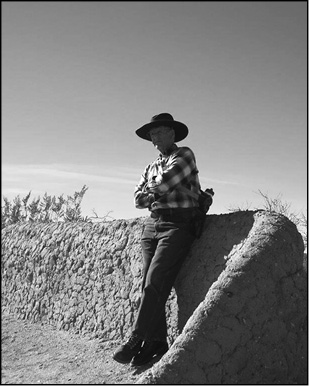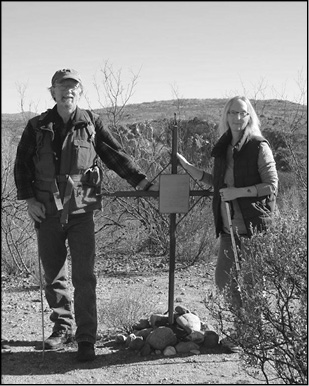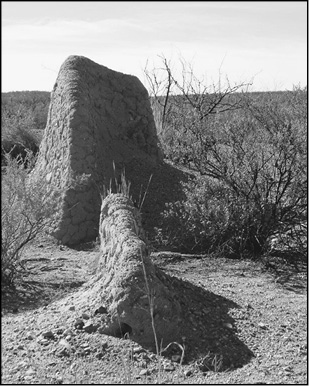Ancient Voices
at the Presidio
One of the questions that, excuse the phrase, haunt us is how spirits from other cultures and from so many different time periods are able to speak English.
For one thing, not all EVPs are in English. Other languages have been recorded in English-speaking countries. For example, Dwight and Rhonda once picked up an EVP recording of an unknown language. They were playing it for a friend in a restaurant in Tombstone when an Apache man approached. He said that the voices on the recorder were speaking Apache. He understood every word spoken.

Dan by the ruins at the Presidio.

Dwight and Rhonda by a marker at the Presidio.

Some of the ruins at the Presidio.
Dwight suggested a logical answer for those spirits who are able to interact with humans living on this plane: they listen and they learn. As modern people enter a place where spirits exist, the spirits hear English spoken. It’s natural that with constant exposure throughout the years they’d pick up the language. One of the best ways to learn a language is through total immersion.
Consider a place like Tombstone’s Birdcage Theater and the tens of thousands of English-speaking tourists who have been through there. Even a remote place such as the Presidio of Santa Cruz de Terrante has had a good bit of traffic since the 1700s. Ancient languages and Spanish, English, and a bit of other modern languages have been spoken there for hundreds of years.
We hiked to the ruins of the Presidio of Santa Cruz de Terrante in 2016. If successful, we expected to encounter cowboys or perhaps Apaches. If we were lucky we hoped to encounter one or more of the Spanish soldiers or support people who lived there several hundred years ago. Much to our surprise, one of the sessions we conducted put us in touch with and speaking with a culture from a time when speech was just beginning.
Presidio of Santa Cruz
de Terrante—Terror on the San Pedro
On August 22, 1775, an Irish mercenary named Hugh O’Connor chose a bluff overlooking the San Pedro River for one of three presidios (forts) he was constructing. The site is a still-remote place a few miles west of Tombstone, Arizona. The road to the trailhead leading to the presidio and the trail itself is easily accessible, although a bit of an easy walk is involved. Several adobe walls remain and the foundations of many others are visible. Structures include the remnants of a fortified wall and gate, a chapel, soldiers’ barracks, commandant’s quarters, guardhouse, and a bastion in which a cannon was placed.
A thick-walled square fortification worked well in many places and had proven its design value in Europe and the Middle East for thousands of years. It wasn’t such an effective deterrent in Apacheria. The Apaches were extremely competent and aggressive guerilla warriors, possibly the best the world has ever seen. The unorganized tribes and clans fought off Spaniards, Mexicans, and Anglos for more than 400 years. In the early years of colonization the warriors used tactics and weapons that the Spaniards just couldn’t overcome. The presidio lasted only five years. The last commandant wrote to the Spanish Crown in 1781, “The terror instilled in the troops and settlers of the presidio of Santa Cruz that had seen two captains and more than eighty men perish at the hands of the enemies in the open rolling ground at a short distance from the post, and the incessant attacks which they suffered from the numerous bands of Apache, who do not permit cultivation of the crops, who surprise the mule trains carrying effects and supplies, who rob the horse herds and put the troops in the situation of not being able to attend their own defense, making them useless for the defense of the province.”
The soldiers, farmers, priests, and others did not have long to wait before hostile Apaches began to harass the settlement, attacking anyone who ventured out for water or tried to plant crops in the nearby fields. The Apaches were attracted by the large number of horses kept at the settlement and ran off the herds whenever they were unguarded. As the number of their horses became fewer, the soldiers were less and less able to pursue the raiders to reclaim their stolen mounts. It became a war of attrition and a very one-sided war it was.
Nearly a hundred men—just on the Spanish side of the battles—perished in less than five years. If there ever was a site for paranormal exploration, Santa Cruz de Terrante had to be included on our list.
When we headed out to visit the presidio we hoped to contact one or more of the troopers or someone supporting the troopers—Spaniards. Who we did encounter within those crumbling adobe walls was an astonishing surprise.
DB: We’re going to be doing a session here. I’m working my pendulum and Rhonda’s going to be asking questions. I’ve already gotten that there are spirits here. The spirits are willing to talk and be recorded. I hope I’m correct. I’m getting a yes.
R: Are there any women … how many women … oh, wait …
DB: You have to ask yes or no questions to narrow it down.
R: Okay, are there less than ten women here with us now?
DB: Yes.
R: Are there less than five women here with us now?
DB: No.
R: Okay, are there seven women here now?
DB: No.
R: Are there eight women here now?
DB: Ah, yes.
R: My mind just went blank.
DB: Welcome to the club. I especially admire the women who came out here.
D: Oh, tough, tough. Unbelievably tough.
DB: I’m getting a no.
R: Were you very frightened all the time?
D: Yes.
R: Did you have children?
DB: Did any of the women have children?
Yes.
R: Did the children work out here? For lack of a better word, did they work with their fathers?
DB: Yes.
Let me ask … is there one spirit here who would like to speak for everybody?
Nope. Everybody wants to chat.
(laughs) Yes.
R: Is Commander Tovar here?
DB: No.
R: Is there a commander here? Commandant?
DB: No.
D: I sense Indian here. I think that this is Indian.
R: Okay.
DB: Are we speaking to Native Americans?
Ah, yes.
R: Okay.
D: Is this your home that we’re sitting in now?
DB: Yes.
D: I thought so.
It was a dome home, wasn’t it? It had a round roof.
DB: That’s a yes.
D: This is a big area. Was this a gathering area?
DB: No.
D: No. It was a home. Okay.
R: Did you have many children? Were there many children here?
DB: Yes.
R: I apologize for asking about the commandant.
DB: Were there white men in the area at the time you were here?
No.
D: No. This was before the fort.
DB: That explains those artifacts on the ground.
R: Yeah.
(The dusty ground revealed the occasional worked stone artifact outside the perimeter of the Presidio indicating a Native American presence prior to the arrival of the Spanish pottery shards from times prior to European invasion, for example.)
D: Before the fort this was a round building with a domed roof.
DB: Like a big wikiup.
D: Exactly like a big wikiup.
DB: Was this a communal home?
Yes.
I’m stopping the (pendulum) movement after every question, so we start fresh.
D: I can see it in my head. I’m almost to the wall of it here. And it was big.
DB: Big yes.
D: It was a big area and I’m seeing a round roof like a dome covered with animal skins.
DB: Yes.
DB: Did the men hunt with what we call a bow and arrow?
No. This may be really old.
D: Spears … did they hunt with spears?
DB: Yes.
R: Wow. I’m so glad they can communicate with us speaking English. Interesting.
Are you Ho Ho Kam?
DB: That’s a yes.
D: This is pottery right here. It just showed up.
(Dwight noticed a pottery shard dating from the Ho Ho Kam era on the ground at that moment. These ancient Native Americans lived in Arizona 1700 years, arriving from Mexico in 300 B.C.)
Honest to God, it just showed up.
R: We want to preserve some of your history.
DB: Your stories are very important to the three of us.
R: Did you have a ball court in this area?
D: No.
R: Okay.
D: I am so in the moment now. I can see exactly—
R: Were there mastodons when you were here?
Elephants. Big creatures with tusks.
DB: I don’t think they understand the question. I’m getting nothing.
R: Well, it wouldn’t have been an elephant back then … big creature with a long trunk? And big horns. And it was big. Did you see those when you were here?
DB: Nothing.
R: Ah … Did you have big cats? Big tigers?
Is that a nothing or—
DB: It’s a small yes.
They had jaguars here back in the day.
R: (speaks to Dwight) What’s that?
D: A piece of bone. I believe a piece of bone. Again it kinda’ just showed up.
DB: That’s a yes.
R: Did you have big animals? Did you hunt big animals when you were here?
DB: Did the tribe hunt big animals?
Yes.
How tall was the wikiup?
D: You could stand in it.
Were the animals that the men hunted as tall as the structure you lived in?
That’s a yes.
Were the animals the men hunted long haired? Shaggy?
Yes.
D: These were the Clovis People.
R: Did the animals that the men hunted have horns?
DB: Yes.
Did they have horns, what we would call tusks, as large as a man?
Yes.
DB: I think we’re in ancient, ancient times.
D: They were Clovis.
DB: Yeah. Did the spear points the men hunted with have a groove down each side of the blade?
Clovis or Folsom. One or the other.
We’re definitely in pre-historic times.
D: Yeah. We are literally right in the middle of a structure.
R: Did you learn English from the people who come out here in today’s time?
DB: Yeah.
Is language ever a barrier of communication between your side and our side?
That’s a yes.
But you understand us?
Strong yes.
D: Yes, strong yes.
Is there anything on this land close to us that we should know about?
DB: Yes.
R: Is it a sacred place?
DB: No.
Should we know about a burial place?
Yes.
Is the reason that we should know it is to honor the lives of those who have passed on?
Yeah. They want us to honor the deceased.
We’re willing to do that.
R: Now we just need to know which direction it is. Is the burial place close to the river? Near the water?
DB: Every place out here is near the water.
R: Okay, is there a direction—
DB: No.
D: I don’t think they want us to go there. I think they want us to—
R: To honor—
D: They want us to know—
DB: They want us to know that they were here.
D: That they were here. And not only are we honoring, of course, their dead, we’re honoring them.
DB: Big swing yes.
That’s a common human drive—we were here.
D: Right. They want us to know they were here.
DB: Big swing yes.
R: A lot of people know that the Spanish were here, and of course the Apache, but …
DB: I’m getting a no.
See, they don’t know about the Spanish or Apache.
D: They were gone before them.
R: So after you were here there were other people here. But most people don’t know that you were here. So, I guess that can be our story to tell—that you were here?
DB: Nice strong yes.
R: We can educate those who come out here.
DB: Is it important for us to tell people that you were here?
Yes.
D: Yes.
DB: That your people were here first.
Strong yes. They’re the forgotten people.
People know about the cowboys and the Apaches and the Spanish and the Mexicans, but—
D: Everybody talks about them, but nobody—
R: Talks about them.
DB: They’re the forgotten people.
You want us to tell other people about you … that you were here?
Yes. They’re okay with it.
D: We will tell your story. We will tell people that you were here. And in doing so hopefully will honor you and the dead on this land.
DB: Strong, strong yes.
D: Very interesting.
DB: Yes.
R: Are you happy over there?
DB: Yes.
R: It’s a good place. Am I right?
DB: Yes.
D: We are happy that you have taken time to communicate with us. We’re happy that you have allowed us to come here and share your space and in return we will do everything we can to tell your story and to tell people that you were here first.
DB: A nice strong yes on that.
An interesting question came from this interview. Notice that at one time the spirits said they were Ho Ho Kam culture, yet clearly from the descriptions we got we were speaking with people from the Clovis Culture who inhabited this part of Arizona 10,000 years earlier. We didn’t know and still don’t know if the spirits were just confused or didn’t understand the term Ho Ho Kam. They might have been answering without understanding just to keep the conversation going. It’s possible that spirits from vastly different cultures and times can get together. That’s a matter for further research. And we will be back. We will honor our promise and not let these people be forgotten.
The EVPs
DB: Yes.
Did they have horns, what we would call tusks, as large as a man?
Yes.
EVP: Yes.
DB: I think we’re in ancient, ancient times.
D: They were Clovis.
To listen to the EVPs go to:
www.beelieveparanormal.com/our-book.html